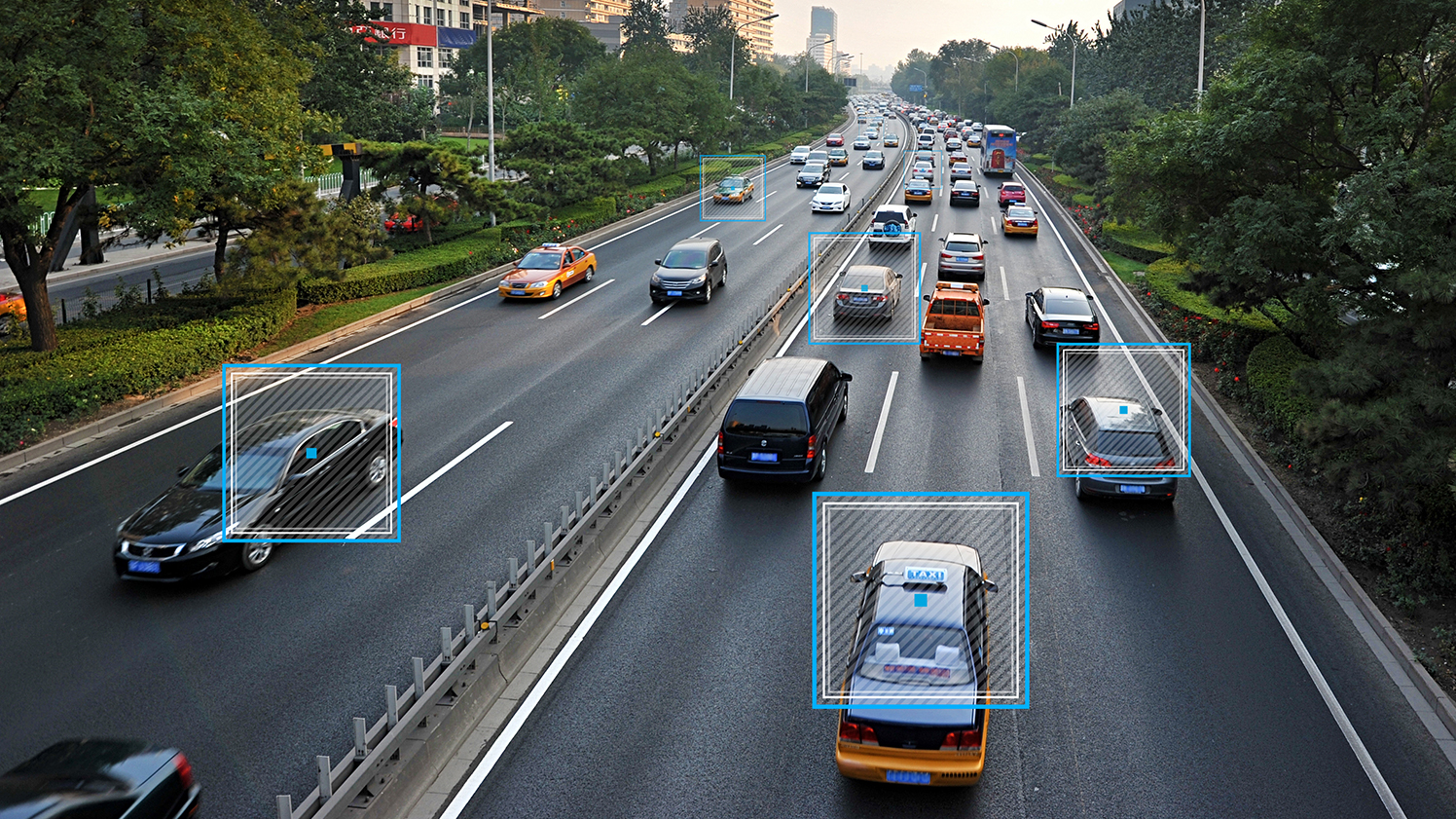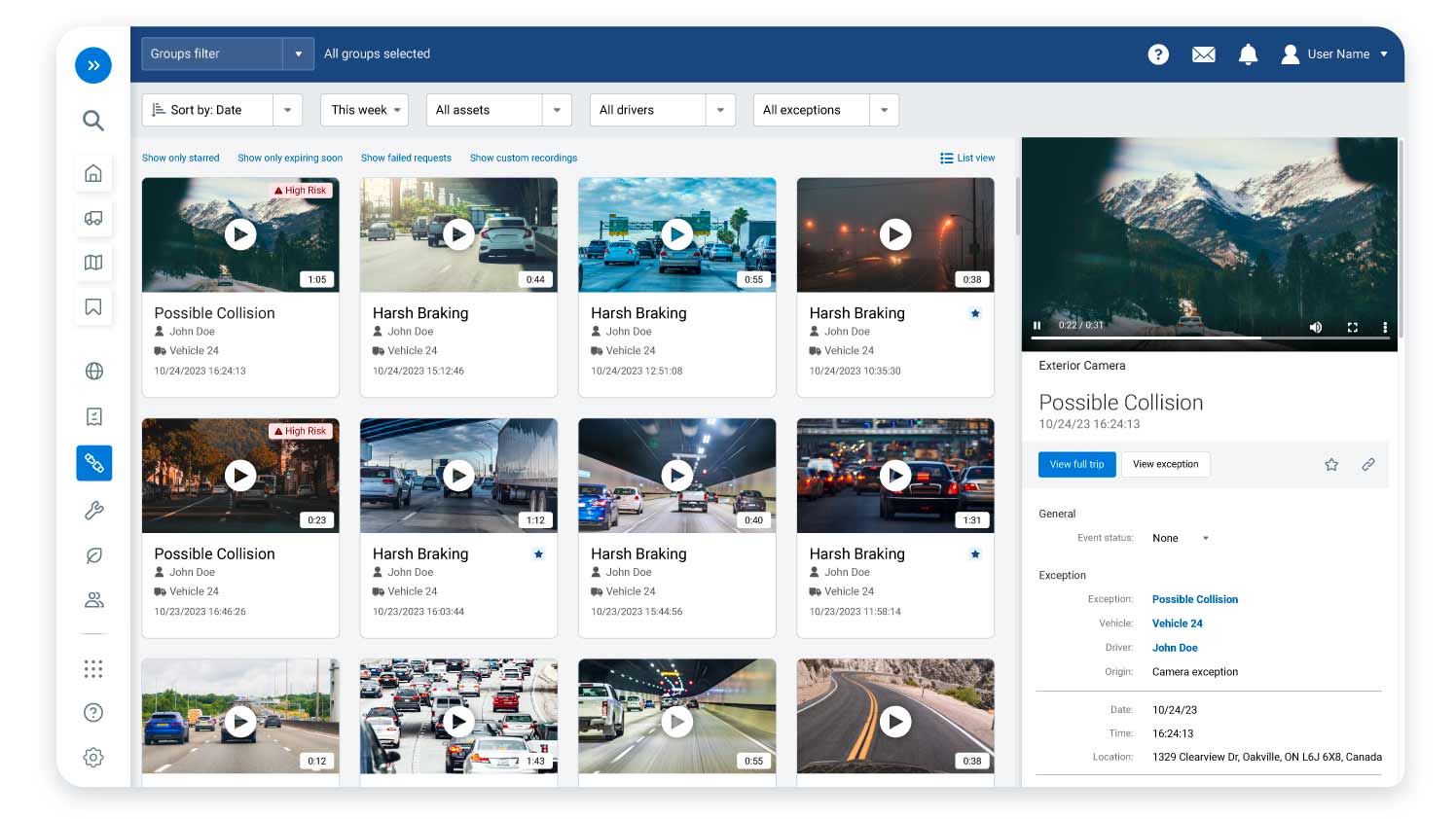Module V – How can cameras and driver assistance systems improve fleet safety?
On the road to fleet safety, it’s an advantage to have more than two eyes. Cameras can see – and record – things drivers can’t.
On the quest for safer roads and efficient fleet management, technology plays a pivotal role. While telematics provides invaluable data on vehicle location, speed and engine diagnostics, video cameras step in as your fleet's silent witness, providing a visual record of driver behavior and road conditions.
Government fleets can significantly improve safety and accountability by using video cameras and Advanced Driver Assistance Systems (ADAS). Video cameras provide valuable insights into driver behavior, helping to identify and address risky driving habits, protect drivers from false claims and monitor driver fatigue. ADAS complements video telematics by providing real-time data and alerts, further enhancing safety measures. The combination of these technologies allows for more effective driver coaching, improved safety policies and a stronger overall safety culture within the fleet.
With the implementation of road-facing cameras, one company saw a 13% decrease in severe alerts, plus improvements in speeding instances, stoplight violations and stop sign infractions.
What is video telematics?
Video telematics takes traditional telematics to the next level by adding video cameras to the mix. This powerful combination provides a more complete and objective picture of what's happening on the road. Video cameras are valuable tools for fleet managers, providing a record of driver behavior, road conditions and incidents. This footage can be used for driver coaching, collision investigation and even to deter theft.
When an event occurs, such as harsh braking or a collision, the dashcam records video footage of the event and sends it to the fleet management platform along with data from the telematics device, such as the vehicle's speed, location and acceleration. The cloud-based platform analyzes the footage and data to provide insights into what happened. This information can be used to:
- Identify the cause of the event
- Coach drivers on how to improve their driving
- Exonerate drivers who were not at fault
- Improve fleet safety policies

Types of dashcams
- Front-facing cameras: These record only what is happening in front of the vehicle. They are useful for assessing road conditions and driver behavior.
- Driver-facing cameras: These monitor driver behavior (e.g., fatigue, distraction).
- Dual-facing cameras: These record both the road ahead and the vehicle's interior. They are helpful for identifying risky driving behaviors and coaching opportunities.
- Rear-facing cameras: To capture events behind the vehicle.
- Side cameras: To provide a wider view of the surroundings.
- 360-degree cameras: These provide a complete view of the vehicle's surroundings. They can be used to determine fault in collisions and deter theft.
Integrating dashcams with telematics
Telematics systems collect data on vehicle locations, speeds and other metrics. By integrating dashcam footage with telematics data, fleet managers can gain a more complete understanding of their fleet. This is known as video telematics.
Video telematics provides valuable insights that can improve safety, efficiency and compliance. For example, it can help identify risky driving behaviors, optimize routes and reduce fuel consumption.
Use case: Tailgating
One of the largest safety risks that some drivers engage in is following the car in front of them too closely. Also known as tailgating, this activity is dangerous because, in the event of a sudden traffic slowdown, not having enough room to stop can result in a collision. To keep better track of how closely your agency's vehicles routinely trail those ahead of them, video telematics can help.
Through AI dashcams, you can record road-facing video that helps you identify risky vehicle spacing patterns. If you notice that tailgating regularly occurs in your fleet, work to eliminate it by promoting more defensive driving by your employees. Additionally, using cabin-facing cameras can enable your managers to watch for and limit distracted driving in the fleet.
With greater insight into what goes on in their vehicles as they're being driven, agencies are empowered to reduce dangerous driving.

What is an Advanced Driver Assistance System (ADAS)?
An ADAS is a collection of electronic technologies that helps drivers with driving and parking functions. ADAS systems help drivers maintain safe control of their vehicles by making them aware of possible issues or temporarily taking over the car's movement to prevent a collision. These systems use a combination of sensors and cameras to detect and respond to potential hazards on the road, often faster than human reaction time can process.
Car manufacturers are increasingly equipping new vehicle models with ADAS to better protect both drivers and pedestrians.
Some common ADAS features include:
- Lane departure warnings: Alerts the driver if the vehicle starts to drift out of its lane
- Lane keeping assistance: Helps keep the vehicle centered in its lane
- Blind spot monitoring: Detects vehicles in the driver's blind spots
- Rear cross traffic alert: Warns the driver of approaching vehicles when backing up
- Traffic sign recognition: Identifies and displays traffic signs
- Driver drowsiness detection: Monitors driver behavior for signs of fatigue
ADAS features can help improve driver safety and reduce the risk of collisions. By providing drivers with real-time feedback and assistance, ADAS can help them make better decisions and avoid potential hazards.
Ebook
Mastering the art of a safer fleet
Lane departure systems have been found to decrease collisions by 11% and injury-related traffic incidents by 21%
How can video telematics and ADAS improve fleet safety?
Video telematics and Advanced Driver Assistance Systems are transforming fleet safety by providing unprecedented insights into driver behavior and enabling proactive collision prevention. These technologies offer a comprehensive approach to enhancing safety, going beyond traditional telematics data.

Reducing collisions
Video telematics captures critical footage that helps identify the root causes of collisions, such as tailgating or distracted driving. Combined with ADAS sensors and features like collision avoidance systems and lane departure warnings, fleets can proactively intervene to prevent collisions.
For example, if a camera detects tailgating, the ADAS system might also detect an unsafe closing speed and trigger an alert or even automatic braking, providing both visual data and active intervention to reduce collisions.
Improving driver behavior
Cameras provide a clear view of driver actions, catching instances of distracted driving, fatigue or other risky behaviors. ADAS complements this by offering real-time alerts for lane departures or potential collisions. By pairing camera-based monitoring with ADAS warnings, fleets can provide targeted driver coaching and promote a safer driving style.
For example, a driver drifting lanes, captured by the camera, would also trigger an ADAS lane departure warning, offering immediate feedback and reinforcement.
Protecting drivers from false claims
In the event of an incident, video footage from telematics systems provides crucial objective evidence. ADAS data, like pre-collision warnings and automated braking events, provides additional context. This combined evidence helps to accurately reconstruct events, determine causes and promote driver accountability while protecting drivers from false claims.
For instance, a video might show a private vehicle cutting off the fleet vehicle, while ADAS data would confirm the sudden braking and evasive action taken, strengthening your driver's case.
Reducing insurance costs
Video telematics captures driving behavior and incidents, providing concrete proof of safety efforts to insurers. This data, alongside ADAS records of safety interventions, shows a proactive approach. Insurers recognize this reduced risk, often leading to lower premiums. Essentially, the tangible evidence of safety improvements translates into financial savings on insurance.
How to choose a video telematics solution
Before choosing a video telematics solution, government fleets should first identify their needs and priorities. Determine the specific safety challenges the fleet faces and what goals they hope to achieve with video telematics. This will help narrow down the features and functionalities required for your fleet.

Features to consider when evaluating a video telematics solution
- Camera options: Consider the types of cameras needed (forward-facing, driver-facing, dual-facing, etc.) and their features, such as video quality, night vision and field of view.
- Reliable data management: Choose a provider that prioritizes data storage, retrieval and privacy. Gain access to historical footage and data when needed, with sufficient memory capacity and secure cloud storage.
- Intelligent event triggers: Automate the review of continuous video footage and allow for configurable rules to trigger footage analysis based on specific events, such as harsh braking or lane departures, streamlining the identification of incidents and risky behaviors.
- Uninterrupted power supply: Maintain continuous recording with backup power options. In case of vehicle power loss, a backup battery will enable the camera to capture critical moments and incidents.
- Advanced Driver-Assistance System (ADAS) functionality:
- Lane departure warnings: Sound an audible alert when a vehicle moves outside of the lane lines without the use of a turn signal.
- Forward collision warnings: Warn drivers that they are following vehicles too closely and a collision may be imminent. This allows them to leave more space between their vehicle and the one ahead.
- Edge computing: This gives cameras with AI technology the processing power needed to detect when a vehicle departs from a lane or is following too closely so that that way drivers can be notified in real time and correct their actions.
- Driver monitoring: Detect risky behaviors, such as distracted or drowsy driving.
- AI functionality: Recognize external objects such as road rules like stop signs or speed limits, humans, vehicles, etc., powering the alerts and warnings used for ADAS.
- Real-time in-cab alerts: Provide immediate feedback to drivers with in-cab alerts. Visual and audible warnings can help correct risky behaviors on the spot, promoting safer driving habits.
- Recording options:
- Driver-initiated: Empower drivers to capture incidents or events by manually activating video recording, providing valuable documentation and context.
- Continuous recording: Go beyond event-triggered recording with continuous capture. This maintains that comprehensive footage is available in case of unexpected incidents, collisions or damage.
- Stationary surveillance: Capture video evidence even when the vehicle is not in motion. This is crucial for incidents that occur while the vehicle is parked or stationary.
- Scalability and flexibility: Choose a solution that can adapt to the fleet's future needs, including potential expansion or changes in technology.
- User-friendliness: The solution should be easy to use and understand for both drivers and fleet managers, with intuitive interfaces and clear reporting dashboards.
- Privacy and security policies: Verify that the solution complies with relevant privacy regulations and data security standards to help protect sensitive information.
Explore vendor reputation and support
Research the vendor's track record, customer support and training resources to facilitate a smooth implementation and retain ongoing assistance.
Request demos and trials
Test the video telematics solution in real-world scenarios to evaluate its effectiveness and compatibility with your operations.
Analyze costs and return on investment (ROI)
Evaluate the total cost of ownership, including hardware, software, installation and ongoing fees, and compare it to the potential return on investment in terms of reduced collisions, improved driver behavior and lower insurance costs.
Video telematics and ADAS are reducing collisions, saving lives and making the roads safer for everyone
Government fleets face unique challenges in enhancing the safety of their drivers and the public and cameras provide extra eyes on the road. By implementing video telematics and ADAS solutions, you can gain valuable insights into driver behavior, identify and mitigate risks and foster a stronger safety culture.
Investing in these technologies can help improve driver behavior, reduce collisions, protect drivers from false claims and optimize fleet operations, ultimately contributing to safer roads and a more efficient agency.

Did you know?
A Geotab customer saw false insurance claims drop by 100% after using video telematics for only six months.